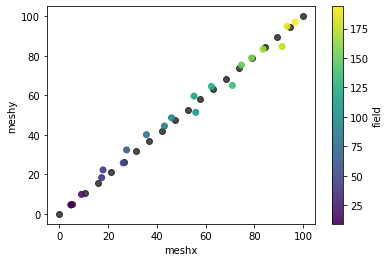You can run this notebook in a live session or view it on Github.
Custom Indexes¶
While Xoak provides some built-in index adapters, it is easy to adapt and register new indexes.
[1]:
import numpy as np
import xarray as xr
import xoak
An instance of xoak.IndexRegistry by default contains a collection of Xoak built-in index adapters:
[2]:
ireg = xoak.IndexRegistry()
ireg
[2]:
<IndexRegistry (5 indexes)>
scipy_kdtree
sklearn_kdtree
sklearn_balltree
sklearn_geo_balltree
s2point
Example: add a brute-force “index”¶
Every Xoak supported index is a subclass of xoak.IndexAdapter that must implement the build and query methods. The IndexRegistry.register decorator may be used to register a new index adpater.
Let’s create and register a new adapter, which simply performs brute-force nearest-neighbor lookup by computing the pairwise distances between all index and query points and finding the minimum distance.
[3]:
from sklearn.metrics.pairwise import pairwise_distances_argmin_min
@ireg.register('brute_force')
class BruteForceIndex(xoak.IndexAdapter):
"""Brute-force nearest neighbor lookup."""
def build(self, points):
# there is no index to build here, just return the points
return points
def query(self, index, points):
positions, distances = pairwise_distances_argmin_min(points, index)
return distances, positions
This new index now appears in the registry:
[4]:
ireg
[4]:
<IndexRegistry (6 indexes)>
scipy_kdtree
sklearn_kdtree
sklearn_balltree
sklearn_geo_balltree
s2point
brute_force
Let’s use this index in the basic example below:
[5]:
# create mesh
shape = (20, 20)
x = np.random.uniform(0, 100, size=shape)
y = np.random.uniform(0, 100, size=shape)
field = x + y
ds_mesh = xr.Dataset(
coords={'meshx': (('x', 'y'), x), 'meshy': (('x', 'y'), y)},
data_vars={'field': (('x', 'y'), field)},
)
# set the brute-force index (doesn't really build any index in this case)
ds_mesh.xoak.set_index(['meshx', 'meshy'], ireg.brute_force)
# create trajectory points
ds_trajectory = xr.Dataset({
'trajx': ('trajectory', np.linspace(0, 100, 20)),
'trajy': ('trajectory', np.linspace(0, 100, 20))
})
# select mesh points
ds_selection = ds_mesh.xoak.sel(
meshx=ds_trajectory.trajx,
meshy=ds_trajectory.trajy
)
# plot results
ds_trajectory.plot.scatter(x='trajx', y='trajy', c='k', alpha=0.7);
ds_selection.plot.scatter(x='meshx', y='meshy', hue='field', alpha=0.9);

[ ]: